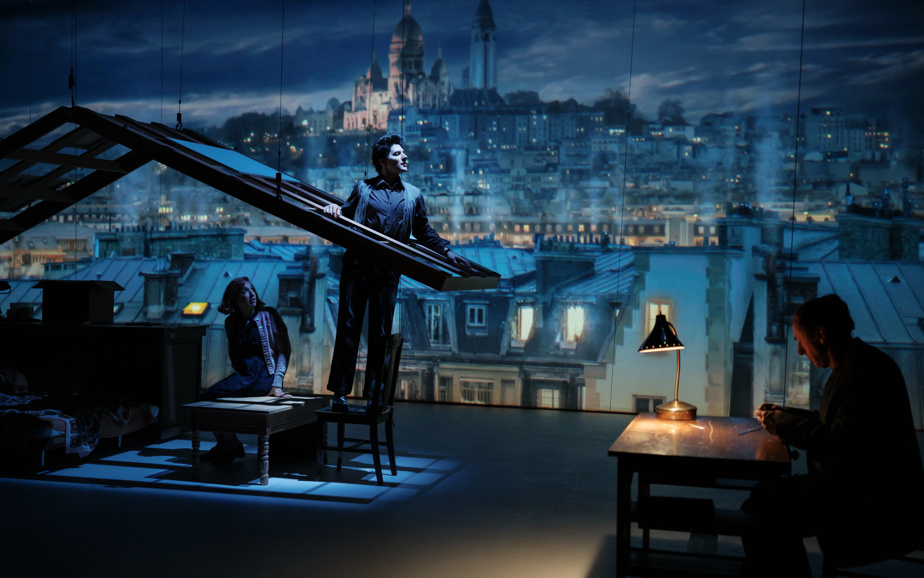In 35 years, Lucie Bazzo has designed the lighting for an impressive number of theater and dance performances. I wanted to meet her. She expressed obvious surprise. It must be said that for the one who handles the light brilliantly, the shadow is the zone in which she prefers to find herself.
I had the idea for this interview because this designer, well known in the arts world, is once again associated with a creation by Robert Lepage. With The Riopelle projecton view at Duceppe, she happily finds the man who made her take her first steps at the end of the 1980s thanks to two river shows.
“It started very strong for me, she confides to me at Café Bloom, located in Pointe-Saint-Charles, the neighborhood she adopted a long time ago. You could say I learned on the job. »
At that time, Lucie Bazzo had just finished the Conservatoire d’art dramatique de Québec, from which she graduated with training in set, costume and prop design. But it is with the desire to make lights that she leaves the institution.
Having noticed his talent during the end-of-year show at the Conservatoire, Robert Lepage asked him to come and work with him on the six-hour version of his famous dragon trilogy which must be presented in June 1987 at hangar noh 9 of the Old Port as part of the Theater Festival of the Americas (FTA). “He was done playing vinci [au Musée des beaux-arts de Montréal] and he came to meet us to do the lighting intensities,” recalls Lucie Bazzo.

PHOTO DANNY TAILLON, PROVIDED BY DUCEPPE
A scene from Riopelle Project
This show is a life-changing experience. “It was my school. I made mistakes. I came home at 8 a.m., picked up and hung up things. I learned a lot of things. »
Then, she continues with the creation of Tectonic plates, show presented in March 1990 at the Jean-Talon station, a disused place at that time. She then became a specialist in non-theatrical places.
She also discovered the world of dance. Many choreographers called on her over the following years: Jocelyne Montpetit, Harold Rhéaume, José Navas, Ginette Laurin, Benoît Lachambre and many others.
In total, Lucie Bazzo created the lighting for 55 theatrical productions and 35 dance performances. These experiences were for the most part fabulous moments of creation. But she also had bad experiences. “I didn’t get pissed off often, but the times it happened, it was because of a misunderstanding on my part or the creator. I remember a show with a choreographer. I didn’t know where to go. She had someone else fix the lights. I planted myself straight. »
For fifteen years, Lucie Bazzo and Robert Lepage took parallel paths. They met with Quillsin 2016, then with SLĀV And Kanata, in 2018. “Yes, I lived through these two periods of crisis,” she simply says with a smirk. Remember that activists have criticized Robert Lepage for demonstrating cultural appropriation and a lack of diversity within these productions.
I’ve always been intrigued by the way designers (sets, costumes, lighting) fit into the director’s approach. How does the mayonnaise manage to rise?
Dialogue between designers is key, she says. It has to merge. Lighting can kill costumes. If you put the wrong blue on a black suit, it will come out brown.
Lucie Bazzo
And then there is the technical aspect. Lucie Bazzo launches into a description of the technologies available to lighting designers today. She loses me in ten seconds. “For a long time, I made plans by hand. Creative residencies that allow us to test things in theater came late. Now, there are software programs that allow us to see things. »
Bazzos, there aren’t tons of them in Montreal. You may have guessed that Lucie is the sister of Marie-France, the radio and TV lady. Their father, of Italian origin, was a longshoreman in the port of Montreal. He married their mother, a Quebecer, who taught sewing.
Our parents wanted us to have liberal professions. My sister and I first studied plastic arts. They had a concern, but they trusted us. My sister then studied sociology and I studied theatre.
Lucie Bazzo
From this training, Lucie Bazzo retained the taste for versatility. In addition to lighting, she devotes herself to photography, a medium for which light is essential. Armed with her phone, she likes to immortalize images borrowed from the city and the night.
During the pandemic, on her bike, she prowled near convenience stores. “That was the only thing open,” she said. She has also produced a series devoted to “cabins of car park. I displayed a certain perplexity as to the beauty of these places. “On the contrary,” she said. There is incredible poetry in there. These huts all have their own personality. But they disappear one by one. »
During the Phénomena festival, you may have noticed these 3D model paintings that appear in shop windows. They are the work of Lucie Bazzo. “These are luminous mini-sets. I add one or two a year. »
Before leaving her, I told her of my astonishment to see that with her rich experience, she does not teach the basics of lighting in theater schools. “I’ve always had impostor syndrome. I’m not very pedagogical. And then, how do I teach something that I’m still learning? »
The Riopelle project is presented until June 11 at the Duceppe theatre. All tickets are sold for the performances.
